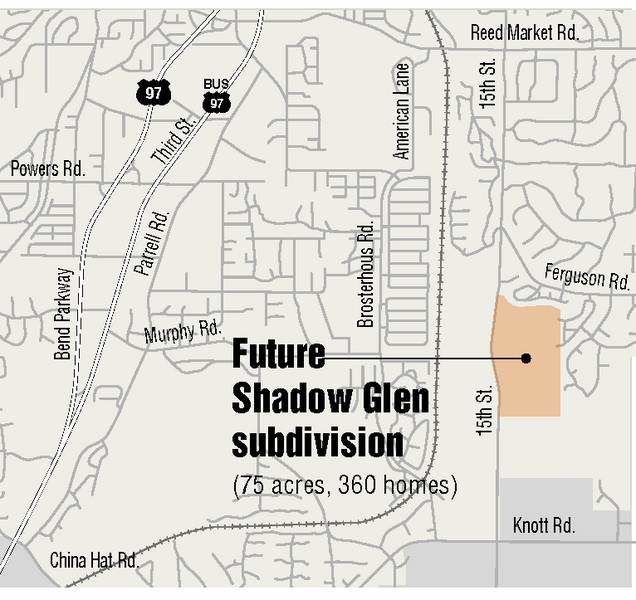Pahlisch to build 360 homes
Published 4:00 am Thursday, March 2, 2006

- Pahlisch to build 360 homes
It’s easy to forget the city in the flat plains around 15th Street in southeast Bend.
Ancient junipers and ponderosa pines jut from the cinder-ash soil. The bitterbrush shares space in a few places with dog tracks and junked furniture, but for the most part the sound of city traffic is nothing but a distant buzz in the country quiet.
That’s about to change.
One of the last big tracts of vacant land left inside the city limits has been bought by one of Central Oregon’s busiest builders.
Pahlisch Homes plans to start work later this year on a 75-acre tract that Dennis Pahlisch and his Rocky Mountain Land Co. bought in December from J.L. Ward Co. and Josele F. Ward for $15 million.
The land is empty now – no streets, no water lines, no sewer. Pahlisch is working on plans for a planned unit development, which means the future of the land will be entirely mapped out before work starts on the first house.
By the time it’s done, 360 homes will rise from the ground in the Shadow Glen subdivision, spread among 18 acres of trails and open space, with a clubhouse and a swimming pool to tie it all together, Pahlisch Homes Marketing Director Brian Bergler said.
If they were built today, the homes would likely cost from $300,000 into the mid-$600,000 range, Bergler said. But he’s reluctant to guess what the price will be by the time the first house is built next year.
With good reason.
Nationwide, housing markets continued to show signs of cooling through January. The nation’s inventory of unsold new homes jumped 20 percent from a year ago, to 528,000, according to the U.S. Commerce Department, and monthly sales fell 5 percent to the lowest level in a year.
In Bend, though, the housing market remains skewed by a key factor – the city is running out of buildable land.
The city’s last update of its Buildable Lands Survey in January counted only 995 acres left inside city limits that are vacant, with no land use requests or subdivision applications pending.
Pahlisch’s 75-acre purchase accounts for a little more than 7.5 percent of that. Beyond that, two more Ward-owned parcels – a 142-acre tract west of Southeast 15th Street, and another 79-acre tract just south of Pahlisch’s purchase – are the two largest lots left that have not been sold to active developers, said Damian Syrnyk, senior planner with the city.
Jan Ward declined to discuss his family’s plans for those lots.
The remainder of the city’s empty acres are scattered here and there in smaller chunks. Some may be developed as the years go by. Others may never enter the marketplace because their owners prefer to keep the space open, or because building on them is otherwise impractical.
Tim Knopp, executive vice president of the Central Oregon Builders Association, estimates that the city is effectively down to a two-year supply of buildable land, or less.
”The builders who are building new communities and subdivisions are really short on subdividable land,” Knopp said. ”They are subsisting on what they bought last year and the year before. Some are going to run out if land isn’t annexed.”
The result: rising prices for land and, with that, rising prices of new housing.
The purchase price on Pahlisch’s land worked out to a little more than $199,000 an acre.
That’s about double the average price of a developable acre only four years ago, according to figures that Bratton Appraisal Group President Dana Bratton gave to a Bend Chamber of Commerce meeting last month, and it’s far from the top rate. Prices in parts of the city have soared into the $500,000-per-acre range.
Under Oregon’s anti-sprawl land use laws, residential-scale development is difficult to do outside of city limits.
In order to expand their boundaries, cities have to establish population growth estimates, then draw maps around new land that could be annexed to accommodate the growth. Plans for sewer and water lines, roads and other infrastructure have to be sketched out, along with plans to pay for them, before an expansion can gain state approval.
City planners hope to have an expansion proposal ready for public hearings by July or August, Syrnyk said. The proposal is likely to call for adding 3,000 to 4,000 acres to the city’s urban growth boundary.
The city expects to need more than 23,000 new housing units by 2030 to accommodate a population of more than 110,000, according to the Community Development Department’s 2005 Housing Needs Analysis.
But even with an expansion of the growth boundary, the pace of future annexations has yet to be decided, Syrnyk said.
What seems assured is that homeowners like Sandy Stock are in for some changes as the city grows.
Stock bought a house on Ridgewater Loop, just across the canal from Pahlisch’s future subdivision, two years ago after he decided to ”trade the tall buildings” of Las Vegas for the tall trees of southeast Bend.
He said he bought the house partly because of the expanse of more than 150 acres of undeveloped land that stretched from his backyard to Knott Road nearly a mile away. But he’s not upset by the coming changes.
Pahlisch’s developers have held a neighborhood meeting to explain what they plan to do. As far as Stock understands it, they plan to leave trees on the far shore of the canal to shield him from the view of new houses
”I think they’re good people,” Stock said. ”And you know, we can’t stop progress. We really can’t. I mean, you know, that’s what’s wrong with people. It’s OK for me to move here, but no one else?
”The way we feel is, we’re lucky to be here.”






